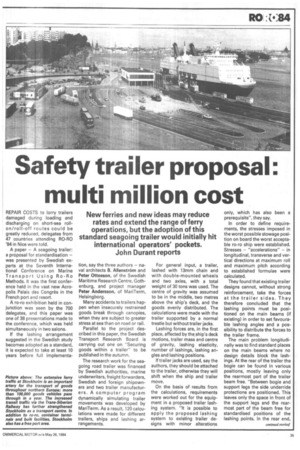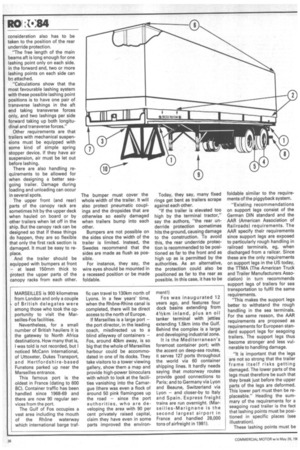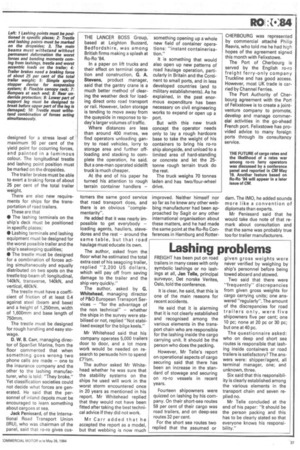Safety trailer proposal: multi million cost
Page 37

Page 38

Page 39

If you've noticed an error in this article please click here to report it so we can fix it.
REPAIR COSTS to lorry trailers damaged during loading and discharging on short-sea rollon/roll-off routes could be greatly reduced, delegates from 47 countries attending RO-RO '84 in Nice were told.
A paper — A seagoing trailer: a proposal for standardisation — was presented by Swedish experts at the Seventh International Conference on Marine Transport Using Ro-Ro Methods. It was the first conference held in the vast new Acropolis Palais des Congres in the French port and resort.
A ro-ro exhibition held in conjunction was seen by the 700 delegates, and this paper was one of 38 presentations made to the conference, which was held simultaneously in two salons.
If the lashing arrangement suggested in the Swedish study becomes adopted as a standard, it is expected to take at least 10 years before full implementa tion, say the three authors — naval architects B. Allenstrom and Peter Ottosson, of the Swedish Maritime Research Centre, Gothenburg, and project manager Peter Andersson, of MariTerm, Helsingborg.
Many accidents to trailers happen when insecurely restrained goods break through canopies, when they are subject to greater stress at sea than on road or rail.
Parallel to the project described in this paper, the Swedish Transport Research Board is carrying out one on "Securing goods within a trailer" to be published in the autumn.
The research work for the seagoing road trailer was financed by Swedish authorities, marine underwriters, freight forwarders, Swedish and foreign shipowners and two trailer manufacturers. A computer program dynamically simulating trailer movements was developed by MariTerm. As a result, 120 calculations were made for different trailers, ships and lashing arrangements. For general input, a trailer, lashed with 13mm chain and with double-mounted wheels and two axles, with a total weight of 30 tons was used. The centre of gravity was assumed to be in the middle, two metres above the ship's deck, and the goods evenly distributed. The calculations were made with the trailer supported by a normal trestle but without trailer jacks.
Lashing forces are, in the first place, affected by the ship's deck motions, trailer mass and centre of gravity, lashing elasticity, number of lashings, lashing angles and lashing positions.
If trailer jacks are used, say the authors, they should be attached to the trailer, otherwise they will shift when the ship and trailer move.
On the basis of results from the calculations, requirements were worked out for the equipment in a proposed trailer lashing system. "It is possible to apply the proposed lashing system to existing trailer designs with minor alterations only, which has also been a prerequisite", they say.
In order to define requirements, the stresses imposed in the worst possible stowage position on board the worst acceptable ro-ro ship were established. Stresses — "accelerations" — in longitudinal, transverse and vertical directions at maximum roll and maximum pitch according to established formulae were calculated.
They found that existing trailer designs cannot, without strong reinforcement, take the forces at the trailer sides. They therefore concluded that the lashing points must be positioned on the main beams (if existing) in order to set favourable lashing angles and a possibility to distribute the forces to the trailer frame.
The main problem longitudinally was to find standard places on the main beams where no design details block the lashings. At the rear of the trailer the bogie can be found in various positions, mostly leaving only the rearmost part of the trailer beam free. "Between bogie and support legs the side underride protections are positioned. This leaves only the space in front of the support legs and the rearmost part of the beam free for standardised positions of the lashing points. In the rear end, consideration also has to be taken to the position of the rear underride protection.
"The free length of the main beams aft is long enough for one lashing point only on each side. in the forward end, two or more lashing points on each side can br.: attached.
"Calculations show that the most favourable lashing system with these possible lashing point positions is to have one pair of transverse lashings in the aft end taking transverse forces only, and two lashings per side forward taking up both longitudinal and transverse forces."
Other requirements are that trailers with mechanical suspensions must be equipped with some kind of simple spring stopper device. If they have air suspension, air must be let out before lashing.
There are also handling requirements to be allowed for when designing a better seagoing trailer. Damage during loading and unloading can occur in several spots.
The upper front (and rear) parts of the canopy rack are sometimes hit by the upper deck when hauled on board or by other trailers when let off in the ship. But the canopy rack can be designed so that if these things do happen, they are so flexible that only the first rack section is damaged. It must be easy to replace.
And the trailer should be equipped with bumpers at front — at least 150mm thick to protect the upper parts of the canopy racks from each other. The bumper must cover the whole width of the trailer. It will also protect pneumatic couplings and the dropsides that are otherwise so easily damaged when trailers bump into each other.
Bumpers are not possible on the sides since the width of the trailer is limited. Instead, the Swedes recommend that the sides are made as flush as possible.
For instance, they say, the wire eyes should be mounted in a recessed position or be made foldable. Today, they say, many fixed rings get bent as trailers scrape against each other.
"If the trailer is elevated too high by the terminal tractor," say the authors, "the rear underride protection sometimes hits the ground, causing damage to the construction. To avoid this, the rear underride protection is recommended to be positioned as far to the front and as high up as is permitted by the authorities. As an alternative, the protection could also be positioned as far to the rear as possible. In this case, it has to be foldable similar to the requirements of the piggyback system.
"Existing recommendations on support legs consist of the German DIN standard and the AAR (American Association of Railroads) requirements. The AAR specify their requirements since support legs are exposed to particularly rough handling in railroad terminals, eg, when discharged from a railcar. Since these are the only requirements on support legs in the US today, the TTMA (The American Truck and Trailer Manufacturers Association) in turn recommends support legs of trailers for sea transportation to fulfil the same requirements.
"This makes the support legs better to withstand the rough handling in the sea terminals. For the same reason, the AAR requirements are proposed as requirements for European standard support legs for seagoing trailers. The support legs thus become stronger and less vulnerable to handling damage.
"It is important that the legs are not so strong that the trailer frame itself risks getting damaged. The lower parts of the legs must therefore be such that they break just before the upper parts of the legs are deformed. This lower part must then be replaceable." Heading the summary of the requirements for a seagoing road trailer is the fact that lashing points must be positioned in specific places (see illustration).
These lashing points must be designed for a stress level of maximum 90 per cent of the yield point for occurring forces, and painted in a luminous colour. The longitudinal trestle and lashing point position must be marked on the dropsides.
The trailer brakes must be able to exert a braking force of about 25 per cent of the total trailer weight.
There are also new requirements for ships for the transportation of road trailers.
These are that • The lashing terminals on the ship's deck must be positioned in specific places; • Lashing terminals and lashing equipment must be designed for the worst possible trailer and the ship's seakeeping qualities; • The trestle must be designed for a combination of forces acting simultaneously and equally distributed on two spots on the trestle top beam of: longitudinal, 140kN, transverse, 140kN, and vertical, 480k N.
The trestle must have a coefficient of friction of at least 0.4 against steel (beam and base) and a height of 1,250mm, width of 1,600mm and base length of 750mm.
The trestle must be designed for rough handling and easy stowage.
D. W. B. Carr, managing director of SpanSet Marine, from the
floor commented that when something goes wrong two
phone calls are made — one to the insurance company and the other to the lashing manufacturer, who is told: "They broke." Yet classification societies could not decide what forces are generated. He said that the personnel of inland depots must be encouraged to learn something about cargoes at sea.
Jack Penissard, of the International Road Transport Union (IRU), who was chairman of the panel, said that ro-ro gives cus THE LANCER BOSS Group,. based at Leighton Buzzard, Bedfordshire, was among British firms making a splash at Ro-Ro '84.
In a paper on lift trucks and their effect on terminal operation and construction, G. A. Stevens, product manager, said that the gantry crane is a much better method of clearing the weather deck for loading direct onto road transport or rail. However, laden storage is tending to move away from the quayside in response to today's larger volumes of traffic.
Where distances are less than around 400 metres, we find operators unloading gantry to road vehicles, lorry to storage area and further offloading and stacking to complete the operation, he said. But a one-man operated sidelift truck is much cheaper.
At the end of his paper he turned his attention to rough terrain container handlers — tomers the same good service that road transport does, and there is an obvious "complementarity".
He added that it was nearly impossible to get everybody — loading agents, hauliers, stevedores and the rest — around the same table, but that road haulage must educate its own.
The author, asked from the floor what he estimated the total extra cost of his seagoing trailer, replied "2,200 US dollars, which will pay off from saving damage to the trailer and the ship very quickly."
The author, asked by G. Whitehead, managing director of MO European Transport Services — "for the advantage of the non technical" — whether the ships in the survey were stabilised or not, replied "Not stabilised except for the bilge keels."
Mr Whitehead said that his company operates 5,000 trailers door to door, and a lot more work would be needed on research to persuade him to spend £71/2m.
The author asked Mr Whitehead whether he was sure that the stability systems on the ships he used will work in the worst storm encountered once in 20 years as mentioned in his report. Mr Whitehead replied that they would not have been fitted after taking the best technical advice if they did not work.
Mr Carr added that he accepted the report as a model, but that webbing is now much something opening up a whole new field of container operations: "instant containerisation."
It is something that would also open up new patterns of road haulage operation, particularly in Britain and the Continent to small ports, and in less developed countries (and to military establishments). As he explained, in the past enormous expenditure has been necessary on civil engineering works to expand or open up a port.
But with this new truck concept the operator needs only to lay a rough hardcore base to take the weight of his containers to bring his ro-ro ship alongside, and unload to a limited area of hard-standing or concrete and let the 25tonne rough terrain truck do the rest.
The truck weighs 70 tonnes laden and has two/four-wheel drive.
improved. Neither himself nor so far as he knew any other webbing manufacturer had been approached by Sagit or any other international organisation about these matters, and he had made the same point at the Ro-Ro Conferences in Hamburg and Rotter CHERBOURG was represented by commercial attaché Philip Reavis, who told me he had high hopes of the agreement signed this month with Felixstowe.
The Port of Cherbourg is served by the English ro-ro freight ferry-only company Truckline and has good access. However, most UK trade is carried by Channel Ferries.
The Port Authority of Cherbourg agreement with the Port of Felixstowe is to create a jointventure company to promote, develop and manage commercial activities in the go-ahead French port. Felixstowe has provided advice to many foreign ports through its consultancy service.
dam. The IMO, he added sounds more like a convention of diplomats than experts.
Mr Penissard said that he would take due note of that remark about consultation and that the same was probably true too for trailer manufacturers.








































































































